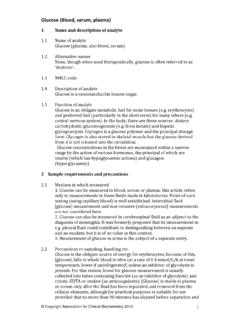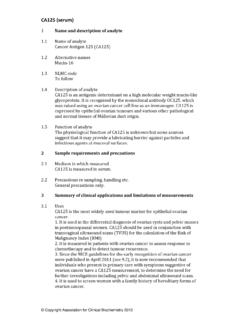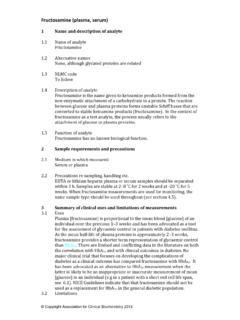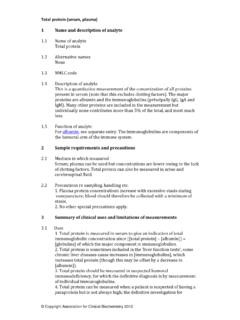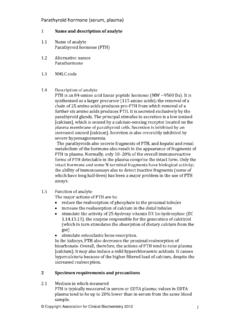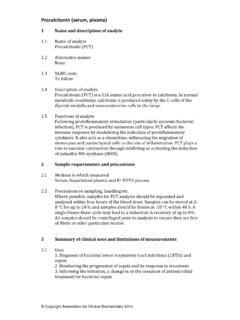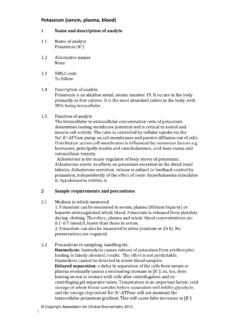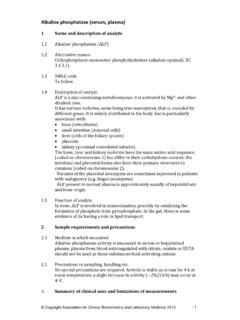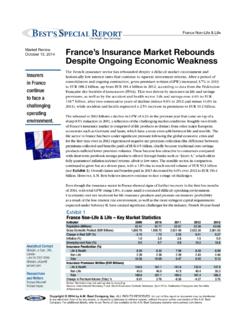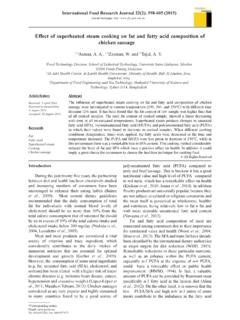Transcription of Creatinine (serum, plasma) - Association for Clinical ...
1 Copyright Association for Clinical Biochemistry 2012 1 Creatinine (serum, plasma) 1 Name and description of analyte Name of analyte Creatinine Alternative names None Description of analyte Creatinine is a heterocyclic nitrogenous compound (IUPAC 2 amino 1 methyl 5H imidazol 4 one), MW 113 Da. It is produced from creatine in muscle at a rate dependent on muscle bulk and is excreted unchanged by the kidneys, mainly by glomerular filtration but to a small extent by active secretion. A small amount of Creatinine (approximately 10%) is derived from dietary sources (particularly cooked meat). Function of analyte Creatinine is not known to have any physiological function: it is a waste product.
2 2 Sample requirements and precautions Medium in which measmured This article relates to the measurement of Creatinine in serum; its measurement in urine may be useful in the assessment of renal function, and as a component of ratios with other analytes in the assessment of their excretion ( calcium: Creatinine ratio) to reduce the variation due to urinary concentration. Precautions re sampling, handling etc. No specific precautions are required. 3 Summary of Clinical uses and limitations of measurements Uses 1. Serum Creatinine measurement is used as a test of renal function. It is superior in this respect to [urea], which is influenced considerably by non renal factors including protein turnover (whether derived from the diet or endogenously) and the state of hydration.
3 2. Serum [ Creatinine ] is used to monitor progression and treatment in acute kidney injury and chronic kidney disease (CKD). In acute kidney injury, the frequency of measurements will usually be guided by Clinical factors and the need to monitor serum [potassium] but is unlikely to be less than once in 24 h. In patients with CKD stages 1 3 ( eGFR 60 mL/min) measurements should be made 6 or at least 12 monthly according to whether eGFR is changing by more or less than 15 mL/min, respectively, between successive measurements; in patients with more advanced CKD, the corresponding figures are 3 and 6 monthly. Copyright Association for Clinical Biochemistry 2012 23.
4 Serum [ Creatinine ] can be combined with measurements of urine Creatinine in timed urine specimens to generate the Creatinine clearance, an indicator of the glomerular filtration rate (GFR). Such measurements have poor reproducibility owing to the imprecision imposed by the difficulty in collecting accurately timed urine specimens. 4. Serum [ Creatinine ] can be used together with demographic information ( age, race, sex) to calculate an estimated GFR (eGFR). In the UK, it is recommended that eGFR should be based on the MDRD (Modification of Diet in Renal Disease) 4 variable formula ( Levey AS, Coresh J, Greene T et al for the Chronic Kidney Disease Epidemiology Collaboration.)
5 Using Standardized Serum Creatinine Values in the Modification of Diet in Renal Disease Study Equation for Estimating Glomerular Filtration Rate. Ann Int Med 2006;145:247 254). However, this concept is open to criticism ( Giles PD, Fitzmaurice DA. Formula estimation of glomerular filtration rare: have we gone wrong? BMJ 2007;334:1198 2000) and is not applicable to several Clinical situations acute kidney disease, children, individuals with muscle wasting etc. Limitations Serum [ Creatinine ] has a wide normal reference interval; it is inversely related to GFR. As a result, GFR may fall to half normal before serum [ Creatinine ] exceeds the upper reference limit. The influence of muscle bulk and, to a much lesser extent, dietary protein intake, on Creatinine production, means that a (slightly) elevated [ Creatinine ] may not indicate impaired renal function 4 Analytical considerations Analytical methods 1.
6 Chemical These methods are based on the Jaff reaction, in which Creatinine reacts with picrate in alkaline solution to form an orange red complex with an absorption maximum at 490 500 nm, which is measured spectrophotometrically. The major drawback of these methods are their lack of specificity: interfering substances include ketones, some drugs, cephalosporins (positive) and bilirubin (negative). This effectively negates the use of end point assays. The effects of interference have been successfully reduced by the adoption of kinetic assays, in which colour generation is typically measured between 20 and 80 seconds after initiation of the reaction (interfering substances tend to have an immediate (<20 sec.))
7 Ketones) or later effect (>80 sec, protein), and reaction conditions, and reagent concentrations are precisely controlled. Such methods are widely used in automated analysers. 2. Enzymatic a. Creatininase ( Creatinine aminohydrolase, EC ) catalyses the conversion of Creatinine to creatine. The latter can be measured through either (1) a reaction catalysed by creatinase (creatine aminohydrolase, EC ) to urea and sarcosine, followed by enzymic measurement of the sarcosine using sarcosine oxidase (EC ) to generate hydrogen peroxide, which is used to oxidise an indicator, or (2) a series of reactions catalysed by creatine kinase (EC ), converting ATP to ADP; pyruvate kinase (EC ) (phosphoenolpyruvate and ADP to Copyright Association for Clinical Biochemistry 2012 3pyruvate and ATP), and L lactate dehydrogenase (EC ) (pyruvate and NADH to lactate and NAD).
8 Various techniques have been devised to reduce interference by endogenous creatine. Method (1) has been adapted for point of care use employing polarographic detection. b. Creatinine deaminase ( Creatinine iminohydrolase EC ) catalyses the conversion of Creatinine to N methylhydantoin and ammonia and provides the basis for another enzymatic method. Both enzymes have been used as the basis for dry slide methods to measure Creatinine . 3. Isotope dilution mass spectrometry (ID MS) This technique is potentially the definitive method, although not suitable for high throughput use. Reference method A candidate reference method is based on isocratic HPLC. Reference material SRM (Standard Reference Material) 967; National Institute for Standards and Technology, Washington DC, USA.
9 Interfering substances See discussion of individual methods. Sources of error. In order to reduce error, and maximise the comparability of [ Creatinine ] measurements (and hence eGFR), most methods are now calibrated against ID MS. This has made unnecessary the previous practice recommended by UKNEQAS that correction factors should be applied to results obtained by routine methods to relate them to ID MS. 5 Reference intervals and variance Reference interval (adults): typically 60 120 mol/L (males), 55 100 mol/L (females) using Jaff based methods Reference intervals: the lower reference limit is lower in children, and varies with body mass. Extent of variation Interindividual CV: 10% Intraindividual CV: Index of individuality: 45% CV of method: Critical difference: 22% Approximately up to 10% of total difference may be accounted for by diet.
10 It should be noted that although the reference intervals for Creatinine are wide, the intra individual variation is relatively low. 6 Clinical uses of measurement and interpretation of results Uses and interpretation 1. Creatinine should be measured in patients suspected of having, or at risk of, impaired renal function, because of shock, dehydration, exposure to potentially nephrotoxic drugs, Clinical evidence of intrinsic renal disease. Copyright Association for Clinical Biochemistry 2012 42. Creatinine should be measured in patients with known renal disease, to monitor the natural history or the response to treatment. Confounding factors The wide reference interval for [ Creatinine ] and its being inversely correlated to glomerular filtration rate (GFR) results in its being an insensitive test for detecting early or relatively mild renal impairment.

